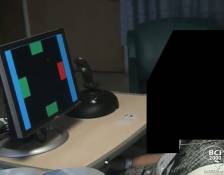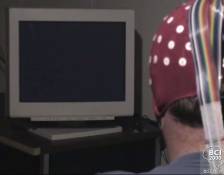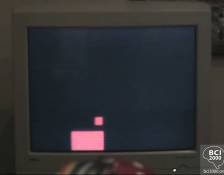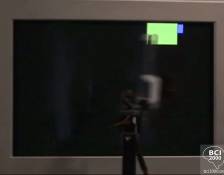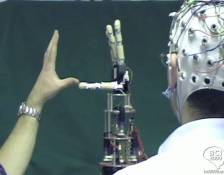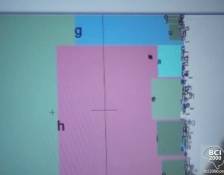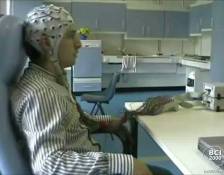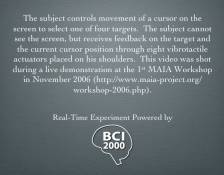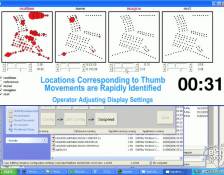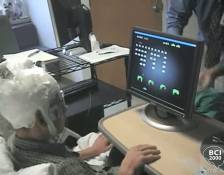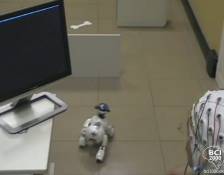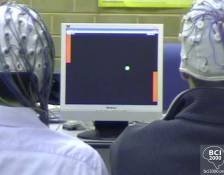The following videos were produced to demonstrate the power of the BCI2000 system through real-life applications. Additional media directly regarding our coverage in the media or of important research achievements may be found here.
Use of BCI2000 By Schalk Lab
July 7, 2007
In this movie showing collaborative research with Dr. Leuthardt, a subject uses electrocorticographic (ECoG) signals recorded from the surface of the brain to control a computer cursor in two dimensions. The subject's task is to hit a target that appears at one of four possible locations. The subject acquired this level of control over the cursor with less than one hour of training. Real-time operation is powered by BCI2000.
February 7, 2007
In this movie of research by Dr. Jon Wolpaw, a person with spinal cord injury uses scalp-recorded sensorimotor rhythms to control a computer cursor in one dimension. The user's task is to hit a target that appears at one of six possible locations. Real-time operation is powered by BCI2000.
January 6, 2007
In this movie of research by Dr. Jon Wolpaw, a person with spinal cord injury uses scalp-recorded sensorimotor rhythms to control a computer cursor in two dimensions. The user's task is to hit a target that appears at one of eight possible locations. Real-time operation is powered by BCI2000.
January 2, 2007
In this movie of research by Dr. Jon Wolpaw, a person with spinal cord injury uses scalp-recorded sensorimotor rhythms to control a robotic arm in two dimensions. The user's task is to hit a target that appears at one of eight possible locations. Real-time operation is powered by BCI2000.
December 1, 2005
This clip is from the Today Show on NBC with Katie Couric. In this show, she uses scalp-recorded EEG to write the word “peace” with the Wadsworth P300-based BCI system.
Use of BCI2000 By Collaborators
February 19, 2008
In this movie, a subject uses scalp-recorded sensorimotor rhythms to control a robotic arm in two dimensions (one dimension controls the thumb; the other dimension controls the other fingers). The subject’s task is to mimick hand gestures shown by a technician.
December 1, 2006
In this movie, a subject uses scalp-recorded sensorimotor rhythms to control a computer cursor in one dimension (up/down). The subject’s task is to select characters using the word processing software “Dasher.” The subject spells the word “hello” in 30 seconds.
November 15, 2006
A subject demonstrates selection of an item from an icon-based menu using a 2-state BCI that is controlled by scalp-recorded mu-rhythm modulation. In a first scene, the subject turns off the light. In a second scene, the subject unlocks the front door (the person entering the room is visible in the lower left panel of the screen, monitored by a video camera). The assistive device software controls each actuator using signals communicated using wireless or powerline communication.
November 15, 2006
The subject controls movement of a cursor on the screen to select one of four targets. The subject cannot see the screen, but receives feedback on the target and the current cursor position through eight vibrotactile actuators placed on his shoulders. This video was shot during a live demonstration at the
October 15, 2006
Electrocorticographic (ECoG) signals are recorded from 128 locations over frontal, temporal, and motor cortices, using BCI2000 software. The subject is instructed to move the left thumb, to imagine the same action, or to rest in response to visual cues. The BCI2000 SIGFRIED module determines activity change in mu/beta frequency bands and translates that change into the diameter of a circle at each electrode location. Areas corresponding to thumb movement are rapidly identified.
September 15, 2006
In this movie, a subject uses electrocorticographic (ECoG) signals recorded from the surface of the brain to control a space ship in the classic game “Space Invaders.” The subject’s task is to steer the space ship left or right so as to avoid being hit. The space ship automatically fires.
September 15, 2005
A subject uses the BCI to navigate a robotic dog along a path to its “bone.” To move the robotic dog in the two dimensions (i.e., up/down and left/right), the subject modulates two independent features of his/her sensorimotor rhythms. Obstacle avoidance integrated in the robot allows the subject to focus on the high-level navigation task only.
February 15, 2005
In this movie, two subjects play the computer game “Pong” while 32 channels of scalp-recorded electroencephalo-graphic (EEG) activity are acquired from each subject. BCI2000 simultaneously processes the EEG signals from each subject, and extracts from each a control signal. These control signals are transmitted to an external application that translates them into the vertical position of the paddles.

